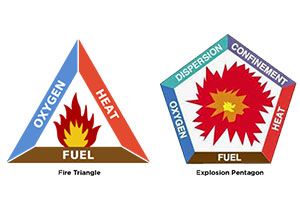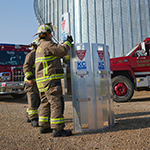Grain bin fires and explosions
Prevent catastrophic fires and grain-dust explosions by implementing programs that properly manage risks and exposures.
The hazards of grain handling and storage are not limited to grain entrapment or engulfment. Other, equally important hazards include sweep augers, toxic gases, chaotic work sites, fires and explosions.
Learn more about the leading causes of grain bin fires and explosions that occur in both on-farm and off-farm grain-handling and storage operations, as well as preventative measures to help avoid catastrophe.
Fire triangle/explosion pentagon diagrams
To avoid fires and explosions within grain-handling and storage operation, it’s important to understand the elements that make up the fire triangle and explosion pentagon diagrams.

Both diagrams illustrate the elements required for a fire or explosion to occur. For example, the fire triangle illustrates that oxygen, fuel and heat are all required to support a fire. Similarly, the explosion pentagram illustrates that oxygen, fuel, heat, confinement and dispersion must all be present in order for an explosion to occur. If any one of these elements is missing from the fire triangle or the explosion pentagon, a fire or explosion cannot occur.
Managing fire and explosion hazards means focusing on strategies to eliminate one or more of the elements required to support a fire or explosion event. Even though oxygen is common to both hazards, it’s difficult to eliminate; therefore, efforts are usually focused on eliminating one of the other required elements.
Fire hazards
Nationwide’s loss experience indicates that fire hazards exist in grain handling primarily due to:
- Hot work operations
- Spontaneous combustion (i.e., biological degradation) of stored grain
- Mechanical/electrical systems
Hot work operations
Our loss experience indicates hot work as the most common source of fires at grain-handling facilities. Hot work is defined as any work process that produces heat sufficient to ignite combustible material. Common examples include cutting, welding, torching, grinding and drilling.
Hot work provides the heat element found in the fire triangle and explosion pentagon diagrams. To eliminate this heat source, always ask if a suitable non-hot work option can be substituted in place of the hot work. For example, rather than placing a weld, maybe work pieces can be joined together utilizing methods that do not produce heat, such as a bolted connection or an epoxy repair.
When hot work must be performed because there isn’t a suitable non hot-work alternative available, look for ways to eliminate the fuel element. In this scenario, fuel refers to any combustible material that could be ignited by the hot work.
The most ideal way to manage this hazard is to relocate hot work to a safe area where combustible materials are not present and mechanisms do not allow for sparks, arcs or slag to travel from the safe area (open-slatted floors, HVAC or dust collection ducts, etc.). If hot work cannot be relocated to a safe area, remove combustible materials from the area or install non-combustible blankets and curtains to provide physical separation.
Commercial grain operators should have a formal hot-work management program in place. In addition to the strategies outlined above, the hot-work management program should prescribe administrative protocols that ensure the completion of a hot-work permit to demonstrate compliance to the program. No hot work should begin until all precautions have been taken and all parties are satisfied that a safe condition exists.
When building a hot work management program or auditing an existing program, it’s useful to know there are multiple standards that address hot work. A recognized and widely utilized standard is the National Fire Protection Agency’s NFPA 51B: Standard for Fire Prevention During Welding, Cutting, and Other Hot Work.
Spontaneous combustion of stored grain
Spontaneous combustion occurs due to microbes that flourish when moisture conditions are elevated in stored grain. These microbes convert the excess moisture into heat, which becomes trapped within the grain pile due to the insulative property of the grain. If enough heat accumulates, the internal temperature of a grain pile can exceed the auto-ignition temperature of grain, resulting in a smoldering fire.
To prevent this heat source, a grain quality management program must be in place to prevent excess moisture build-up and provide a routine inspection system to identify when grain may be going out of condition.
Fires that result from spontaneous combustion can be very difficult to extinguish due to the large quantity of grain that may be stockpiled in flat storage or in tanks. Reaching the affected area within a stockpile often requires the movement of a tremendous amount of grain. Compounding the issue is that a smoldering fire often becomes a raging inferno once the grain is exposed to oxygen.
All grain operators should conduct incident planning for a spontaneous combustion event and develop an action plan to address this scenario.
Mechanical/electrical systems
To manage mechanical and electrical system hazards, consider:
- Loss prevention, which includes equipment preventive maintenance, hazard monitoring systems and equipment selection (appropriate for the location)
- Loss reduction (isolation of the conveying process)
Explosion hazards
As seeds or kernels are handled, grain dust is produced and can become suspended in air or accumulate on floors, ledges, beams and equipment. Explosion hazards typically exists in two capacities:
- Fugitive dust, which is dust that escapes into the atmosphere from where it is generated
- Equipment operating under normal conditions with an explosive concentration of dust
When conditions are right, suspended grain dust can ignite and explode, causing catastrophic damage and huge financial and human loss.
Fugitive dust
Fugitive dust is dust that escapes into the atmosphere from the place where it’s generated. In the context of grain handling, fugitive dust is explosive in certain concentrations. To manage the hazard, controls must be in place to eliminate dispersion of this dust into the atmosphere, effectively preventing the fugitive dust cloud from reaching the lower explosive limit of grain dust.
Dispersion elimination strategies include the use of:
- Enclosed conveying equipment
- Dust suppression methods, such as grain oiling
- Dust collection devices at points in the conveying process where grains are agitated
This hazard can also be managed by addressing potential sources of heat that could ignite a dust cloud. Ignition sources may include electrical components, hot bearings and contact between moving metallic components. To manage these potential ignition sources, ensure electrical components and motors are specifically rated as suitable for use in Class II, Division 1 or 2 and Group G hazardous locations. Also make sure bearings and metallic moving parts are routinely inspected and serviced as part of a preventive maintenance program.
Another strategy to manage the explosion hazard from fugitive dust is to eliminate confinement. Confinement strategies include locating equipment outdoors or installing explosion venting on building structures that house grain handling equipment. (Note: this particular risk management strategy is a loss reduction method — that is, it reduces the severity of a loss but does not prevent the loss from occurring.)
While loss reduction methods are a legitimate part of an overall risk management strategy, recognize that loss prevention methods (methods that prevent a loss from occurring) are always preferred over loss reduction methods.
Dust internal to equipment
Under normal operating conditions, an explosive quantity of dust is contained within certain pieces of grain-handling equipment, such as bucket elevators, conveyors, distributors and bins. Similar to how the explosion hazard is managed for fugitive dust, dispersion can be maintained through dust suppression methods, such as grain oiling and dust collection devices installed at key points along the process flow where grain is agitated.
This hazard can also be managed by addressing the heat sources that could ignite the dust cloud within the equipment. Sources of heat might include electrical components, bearings and contact between moving metallic components. To manage these potential ignition sources, make sure electrical components are specifically rated as suitable for use in Class II, Division 1 or 2, Group G hazardous locations. Also make sure bearings are externally mounted and metallic moving parts are routinely inspected and serviced as part of an equipment preventive maintenance program.
Additional heat sources of heat within equipment include the practice of “jogging” motors to clear a jam or obstruction. This practice increases the likelihood the mechanical drive will slip relative to the belt, creating friction, which generates heat. Administrative protocols should in place that prohibit jogging.
Hazard-monitoring systems can provide a degree of safety when operating equipment that contains an explosive quantity of dust. Hazard-monitoring systems monitor common heat sources, such as bearing temperatures, belt alignment to ensure the belt does not rub against the bucket elevator casing and belt-speed differential to ensure the belt is not slipping on the drive pulley.
To eliminate confinement, use the loss-reduction method of selecting equipment that has explosion panels built into the equipment housings.
Dust and ignition-control program
The development and implementation of a comprehensive dust and ignition-control program is vital to preventing primary explosions and mitigating additional damage caused by fugitive dust buildup.
Occupational Safety & Health Administration (OSHA) and National Fire Protection Association (NFPA) have strict standards on the control of dust and ignition sources to prevent explosions — and so do we.
The following are some of their recommendations and ours:
Ignition control
- Establish preventative maintenance program. Without preventative maintenance, bearings, belts, buckets, pulleys and milling machinery become potential ignition sources. Periodic inspection, cleaning, lubrication, alignment and tightening are critical to keeping equipment functioning properly and safely.
- Install and maintain motion and alignment-monitoring devices. These devices help detect slippages, misalignments or bearing failures.
- Install and maintain magnets at receiving pits. Magnets remove foreign objects and ferrous (iron) material from the incoming grain stream by materials that can cause sparks and damage equipment as they move through augers, legs and milling equipment.
- Use appropriate electrical equipment and wiring methods. Use of inappropriate electrical equipment, faulty installations and lack of electrical maintenance are fire hazards and require safeguards.
- De-energize or remove all machinery that presents an ignition source before using compressed air to clean. Regulations require the entire elevator to be de-energized before blowdown can occur. We take it a step further by not recommending the use of compressed air for cleaning. Sweeping and vacuuming are safer alternatives.
- Control open flames and sparks. Require the issuance of a hot work permit for all work involving electric or gas welding, cutting and brazing or similar flame or spark producing operations.
- Strictly enforce a no-smoking policy. “NO SMOKING” signs should be posted in key locations.
Dust control
- Analyze entire grain-handling system. Determine where dust accumulations occur and how to best control or eliminate them. Pay special attention to areas that allow extra dust to accumulate, such as holes in spouting, casings of bucket elevators, pneumatic conveying pipes, screw augers and drag conveyer casings. Areas in need of repair should be repaired immediately.
- Consider food-grade mineral oil. Spraying edible oil on or into a moving stream can help control dust emissions. See Control Grain Dust Emissions With Oil.
- Develop and implement a written housekeeping program. Follow a written clean-up schedule to help ensure all areas are inspected and cleaned daily — more frequently during peak periods of operation.
- Inspect for dust residues. Open and enclosed areas should be inspected at regular intervals. No area is off limits. Remember to check pipes, ledges, beams and equipment.
- Control the use of compressed air to blow dust from ledges, walls and other areas. Regulations require the use of an air blowdown permit to help ensure all necessary precautions are taken before compressed air is used; however, Nationwide does not recommend the use of compressed air for cleaning. Sweeping and vacuuming are safer alternatives.
- Minimize the free fall of grain. Use choke feeding techniques and dust-tight enclosures at all transfer points.
- Use properly designed pneumatic dust collection systems. Follow maintenance, testing and inspection guidelines recommended by the manufacturer. Collectors must be equipped with a monitoring device (capable of being read at an accessible location and checked frequently) to indicate when maintenance, such as a filter change, is required.
- Install dust aspiration systems. With proper aspiration, dust concentrations in legs and conveyers can be kept below the lower explosive limits.
- Minimize the escape of dust from process equipment or ventilation systems. Consider enclosing the conveying system, pressurizing the general work area and providing a lower pressure inside the enclosed conveying system.
- Put a contingency plan in place. This helps operators deal with dust that accumulates rapidly following an equipment or system failure.
Employee training
Employee training on how to recognize and prevent fire and explosion hazards is a major component of a successful dust and ignition-control program. Employees are the first line of defense, so they should be trained thoroughly and often, as well as be empowered to take preventative/corrective actions or alert management at the first sign of a dust-control problem.
Putting it all together
As on-farm and off-farm grain-handling and storage operations become larger, it becomes even more important to be aware of the sources that can lead to fires and explosions. Following safe grain-handling and storage practices is essential to keeping an operation running efficiently and smoothly. Most importantly, following these practices and implementing an effective employee training program is critical in preventing catastrophic damage and huge financial and most importantly — human loss.

 >
>

 >
>
 >
>